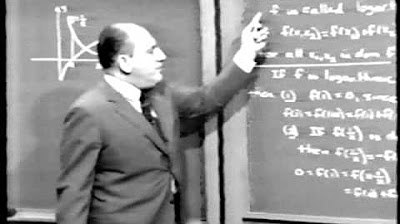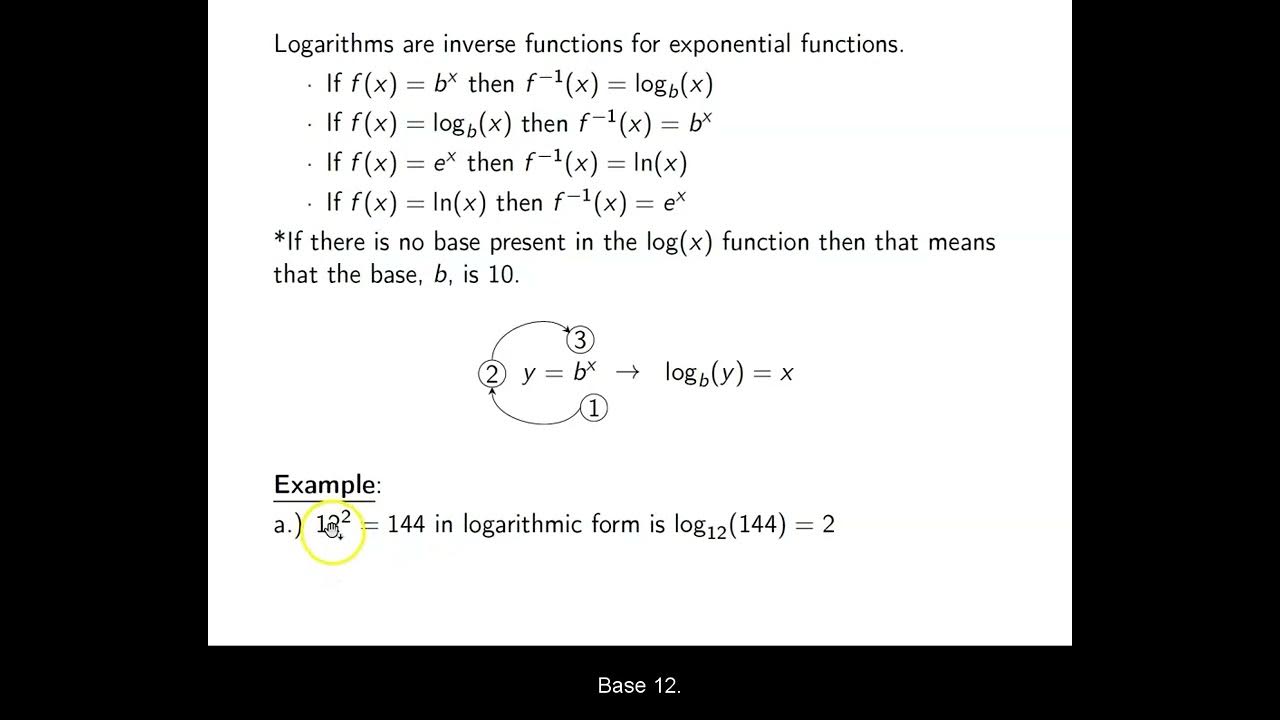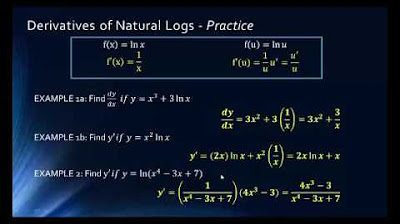Unit V: Lec 2 | MIT Calculus Revisited: Single Variable Calculus
TLDRThis MIT OpenCourseWare lecture delves into 'Inverse Logarithms', focusing on the natural logarithm's inverse function, which is the exponential function. The professor illustrates the process of inverting functions, the properties of the natural logarithm, and how they transfer to its inverse, including the unique characteristic that the inverse function is its own derivative. The lecture also touches on the application of exponential functions in solving second-order differential equations, showcasing the power of exponential properties in mathematical analysis.
Takeaways
- 📚 The lesson is about 'Inverse Logarithms', focusing on the natural logarithm and its inverse function.
- 🔄 The natural logarithm function is defined by its derivative being '1/x' and passing through the point (1, 0), which ensures it is a one-to-one function with an inverse.
- 🤔 The process of finding an inverse function involves reflecting the graph over the line y=x, which is demonstrated for the natural logarithm.
- 📈 The inverse of the natural logarithm is characterized by the exponential property, where the inverse log of a sum is the product of the individual inverse logs.
- 🧩 By assigning variables to the inverse log of individual numbers, the professor illustrates the property that the inverse log of a sum equals the product of the inverse logs.
- 📉 The derivative of the inverse natural logarithm ('e to the x') with respect to 'x' is shown to be the function itself, indicating its self-reinforcing nature under differentiation.
- 🔢 The script explains how to differentiate composite functions involving exponentials using the chain rule, emphasizing the derivative of 'e to the u' with respect to 'x'.
- 🧬 The professor uses the properties of the natural logarithm to solve integrals involving 'e to the minus x squared', demonstrating the simplification process.
- 💡 A powerful application of the derivative property of exponential functions is shown in solving second-order differential equations by substituting 'y' with 'e to the rx'.
- 🔑 The technique of solving second-order differential equations is highlighted by transforming them into quadratic equations, allowing for the determination of the constant 'r'.
- 🔚 The lesson concludes by emphasizing the importance of understanding the natural logarithm to derive all properties of its inverse, the exponential function.
Q & A
What is the main topic of the lesson?
-The main topic of the lesson is 'Inverse Logarithms', specifically focusing on the properties and applications of the inverse of the natural logarithm function.
What is the natural logarithm function defined by?
-The natural logarithm function is defined as the function whose derivative with respect to 'x' is '1/x' and passes through the point (1, 0), for positive 'x'.
Why does the inverse function of the natural logarithm exist?
-The inverse function exists because the natural logarithm function is one-to-one, meaning each input has a unique output, which is a requirement for a function to have an inverse.
How is the graph of the inverse logarithm function obtained from the graph of the natural logarithm?
-The graph of the inverse logarithm function is obtained by reflecting the graph of the natural logarithm with respect to the line y = x.
What is the relationship between the natural logarithm and its inverse in terms of their properties?
-The inverse of the natural logarithm function has the usual exponential property, which means if you take the inverse log of the sum of two numbers, it is equivalent to the product of the inverse logs of the individual numbers.
What is the derivative of the inverse natural logarithm function with respect to x, if y is the inverse natural logarithm of x?
-The derivative of the inverse natural logarithm function with respect to x, denoted as dy/dx, is equal to y itself, showing that it is its own derivative.
What is the conventional notation for the inverse of the natural logarithm function?
-The conventional notation for the inverse of the natural logarithm function is 'e to the x', where 'e' is the base of the natural logarithm, approximately between 2 and 4.
How can the properties of the natural logarithm be used to solve integrals involving the exponential function?
-The properties of the natural logarithm can be used to simplify integrals of the form 'e to the u' with respect to 'u', where 'u' is a function of 'x', by using the chain rule and the fact that the derivative of 'e to the u' with respect to 'u' is 'e to the u'.
What is a second-order differential equation, and how can the properties of the exponential function help solve it?
-A second-order differential equation is an equation where the highest derivative present is the second derivative. The properties of the exponential function can be used to solve it by substituting 'y' with 'e to the rx' and transforming the differential equation into a quadratic equation in 'r'.
How can the derivative property of the exponential function be used to check solutions of a second-order differential equation?
-By substituting the proposed solution 'y' with 'e to the rx' into the second-order differential equation and simplifying, if the resulting expression is identically zero, it confirms that the proposed solution is correct.
Outlines
📚 Introduction to Inverse Logarithms
The first paragraph introduces the topic of the video, which is the concept of 'Inverse Logarithms', specifically focusing on the natural logarithm. The professor explains that the natural logarithm is a one-to-one function, meaning it has an inverse. The process of finding an inverse function is discussed, including the graphical method of reflection over the line y=x. The paragraph concludes with the observation that the inverse of the natural logarithm has an exponential property, setting the stage for further exploration of inverse functions.
🔍 Deriving the Inverse Logarithm Properties
In the second paragraph, the professor delves deeper into the properties of the inverse logarithm, using the natural logarithm's properties as a foundation. The discussion revolves around the exponential function's defining characteristic and how it translates to the inverse function. The professor illustrates this by showing that the inverse log of a sum is equivalent to the product of the individual inverse logs. This is achieved through a step-by-step algebraic manipulation that reinforces the relationship between the natural logarithm and its inverse.
📘 Calculus of the Inverse Natural Logarithm
The third paragraph shifts the focus to the calculus properties of the inverse natural logarithm. The professor explains how to find the derivative of the inverse natural logarithm, which is a straightforward process due to its relationship with the natural logarithm. The key takeaway is that the derivative of the inverse natural logarithm function, when expressed as 'e to the x', is the function itself, highlighting a unique and powerful property of the exponential function.
🧩 Applications of Exponential Functions in Integrals
The fourth paragraph discusses the application of exponential functions in integral calculus, specifically in solving integrals of the form 'e to the u' with respect to 'u'. The professor demonstrates how to simplify complex integrals by using substitution and the properties of exponential functions. The example given involves integrating a function that includes an exponential term with a quadratic exponent, showing how the integral can be simplified to a basic exponential function plus a constant.
🔧 Solving Second-Order Differential Equations with Exponentials
In the final paragraph, the professor introduces a technique for solving second-order differential equations using exponential functions. By proposing a trial solution in the form of 'e to the rx', where 'r' is a constant, the professor shows how to transform the differential equation into a quadratic equation. This allows for the determination of the values of 'r' that satisfy the equation, providing solutions in the form of exponential functions. The paragraph concludes with a brief mention of further exploration of exponential functions in upcoming lectures.
Mindmap
Keywords
💡Inverse Logarithm
💡Natural Logarithm
💡One-to-One Function
💡Derivative
💡Exponential Function
💡Differentiation
💡Integration
💡Second-Order Differential Equations
💡Chain Rule
💡Quadratic Equation
Highlights
Introduction to the concept of 'Inverse Logarithm' as a revisit to inverse functions, specifically applied to the natural logarithm.
The natural logarithm function is uniquely defined by its derivative being '1/x' and passing through the point (1, 0).
Explanation of the one-to-one nature of the natural logarithm function, which allows for the existence of an inverse function.
Visualization of the inverse logarithm graph as a reflection over the line y = x.
The inverse logarithm of 0 is 1, as shown by the inverse point (0, 1) on the graph.
The exponential property of the natural logarithm's inverse function, relating to the multiplication of exponentials.
Proof that the inverse log of the sum of two numbers equals the product of their inverse logs.
Derivation of the inverse natural log function's derivative, showing it to be its own derivative.
The unique property of the inverse natural log function being non-destructible with respect to differentiation.
The conventional notation of the inverse natural log as 'e to the x', rather than 'inverse log x'.
The identification of 'e to the x' with the natural logarithm to the base 'e', and its significance.
Application of the chain rule to find the derivative of 'e to the u' with respect to 'x'.
Discussion on the difficulty of integrating 'e to the minus x squared' and its relation to the natural logarithm.
Technique for solving second-order differential equations using exponential functions as trial solutions.
Solution of a specific second-order differential equation using the properties of the exponential function.
The powerful structural property of the exponential function where its derivative is the function itself.
Final thoughts on how understanding the natural logarithm function leads to a complete understanding of its inverse.
Transcripts
Browse More Related Video

Lec 7: Exam 1 review | MIT 18.01 Single Variable Calculus, Fall 2007

Derivatives of inverse functions | Advanced derivatives | AP Calculus AB | Khan Academy

2.3 - Derivatives of Logarithmic Functions

Unit V: Lec 1 | MIT Calculus Revisited: Single Variable Calculus

Ch. 4.3 Logarithmic Functions

Math1325 Lecture 11 1 Derivatives of Logarithm
5.0 / 5 (0 votes)
Thanks for rating: